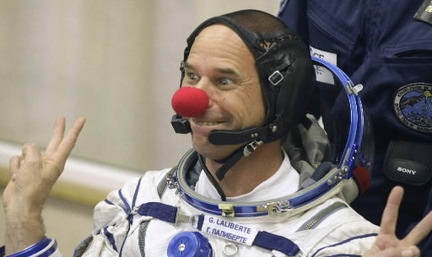[/caption]
According to a Russian official, the commercial space company Space Adventures will be sending two space tourists a year into orbit on Soyuz spacecraft from beginning in 2012. “We have been working on this project for a number of years” said Sergey Kostenko, the head of the company’s office in Russia, who was quoted in the Russian news website RiaNovosti. “Each Soyuz will carry two tourists and a professional astronaut. One of the tourists will have to pass a year-and-a-half training course as a flight engineer.”
Space Adventures has been authorized by the Russian Federal Space Agency Roscosmos to select and contract candidates for space tourist trips. According to Kostenko, Russia’s RSC Energia corporation has the capacity to build five Soyuz spacecraft per year instead of four, meaning that Space Adventures will be able to use at least one Soyuz for space tourism purposes.
“The International Space Station (ISS) program requires four Soyuz spacecraft per year, and we have been informed by RSC Energia that they will be able to increase the annual production to five spacecraft,” he said, adding that Space Adventures would pay for the construction of the extra Soyuz, the launch services and the salary of a Russian cosmonaut as crew commander.
Kostenko said Space Adventrues, which bills itself as the only company currently providing human space mission opportunities to the world marketplace, already had a number of candidates who were willing to pay for trips into space, including Russian-born American billionaire and Google co-founder Sergey Brin.
The current price of a 10-day trip to the ISS for a tourist is estimated at about $35 million USD.

Space tourists started flying to the International Space Station in 2001 when American businessman and former NASA scientist Dennis Tito flew to the ISS aboard a Soyuz. He was followed by South African computer millionaire Mark Shuttleworth in 2002, and Gregory Olsen, a U.S. entrepreneur and scientist, in 2005.
In 2006, Anousheh Ansari, a U.S. citizen of Iranian descent, became the first female space tourist.
U.S. games developer Richard Garriott, the son of former NASA astronaut Owen K. Garriott, went into orbit for 11 days in October 2008 on board a Russian Soyuz TMA-13.
U.S. space tourist Charles Simonyi, one of the founders of Microsoft, made two trips to the ISS – in 2005 and 2009.
Guy Laliberte, the Canadian founder of entertainment company Cirque du Soleil, arrived at the ISS on Friday and will stay on board until October 10.
Source: Ria Novosti


Two words: space sex.
Not that that’ll get my knickers in a twist. I just wish they’d charge people enough to actually pay for extra Soyuzes to use less frivolously.
I’m all for civilian access to space but I question whether paying ‘space tourists’ traveling to the ISS is the way to go. What will happen to mission specialists aboard the Space Station to tend to their experiments? This may generate money for Roscosmos but what happened to the science that’s to be done in Low Earth Orbit?
I wonder what NASAs take on all of this is (or JAXA, ESA, and the Canadian Space Agency). Does NASA or other member nations of the ISS program get a cut of the proceeds from the Russians? It seems rather ironic that all the trillions of dollars spent by the international Space Station partners are now being utilized by the cash-strapped Russians to bring ‘space tourists’ on board. Seeing that space travel – even to LEO – is a dangerous and technically challenging endeavour, why risk potential disaster by sending civilians to the ISS, possibly endangering not only themselves but the ISS and its 6 member crew (besides the money made by Rocosmos). The only rational I can see for this venture is money and publicity.
On IIS tourism, I note that the updated SpaxeX launch manifest puts down a Bigelow Aerospace Falcon-9 launch in mid of 2011. Money is on this large launch being a full scale demonstrator but perhaps also the first used private space habitat.
IIRC Bigelow’s plan, they want to put the habitat a few hundred meters from ISS. This would then put ISS tourists as passing by way of Soyuz (and relying on ISS for safe harbor).
SpaceX now officially states that they can man qualify Dragon capsules, which will have automatic docking capabilities, in 3 years after investment and approval. This would put a ISS/Soyuz independent space habitation industry earliest in 2014.
Seems that successful commercialization will give a palette of possibilities, including that Russians continue with tourism if allowed.
@ Torbjorn Larsson OM: I think the private programs you mentioned in your post are right on the money. Space habitats co-orbiting with the ISS seems like a sensible solution for the rapidly growing ‘space tourist’ enterprise. It just makes logistical sense. Both the cargo transfer vehicles from ESA and JAXA might also be coverted to carry human cargo to (and eventually from) the ISS or other LEO facilities.
BTW, regarding docking of the Dragon capsule to the ISS, it seems that docking will be accomplished using the ISS Canadarm 2 like the JAXA cargo vehicle. Per Wiki: “As Dragon will feature a standard ISS Common Berthing Mechanism (CBM), Dragon will be berthed to the ISS using the Space Station’s robotic arm, thus avoiding the added weight, extra cost and complexity of an on-board docking system such as APAS-89 or the LIDS.”
two sources that i came across online stated the cost of an entire soyuz mission as being about sixty-five million dollars. if those sources were correct, bringing billionare clowns into space can cut your launch costs in half.